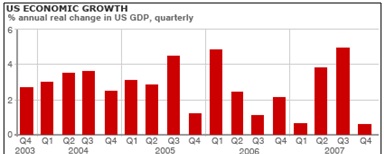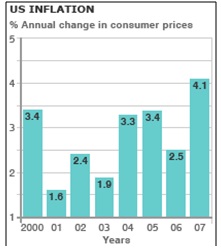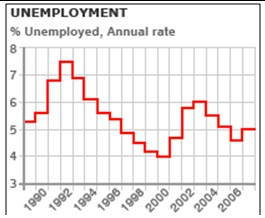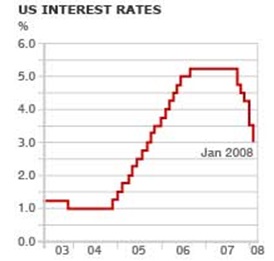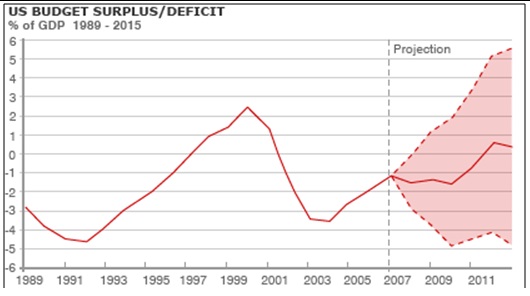Introduction
The US economy and in turn the world economy seems to have taken a turn for the worse and with the recession being forecast in the next quarters. There is also a comparison with the great depression of the 1930s that left the country in a massive collapse. This paper examines the economic outlook of the US from 2007 to 2008 and recommends some remedial measures for the Federal Reserve Board to tackle the problem.
US Economy from 2007 to 2008 – Macro Indicators
According to the reports released by the Bureau of Economic Affairs (BEA, 2008), the U.S. GDP growth for quarter 4 of 2007 remained at.6%. Economic growth fell from 4.9% in quarter 3, and 3.9% in quarter 2 of 2007. The total GDP for 2007 was 2.2% while the 2006 figures gave growth of 2.9%. This figure of GDP had occurred in quarter 1 of 2003. The decline in growth has been blamed on the subprime mortgage crash, the housing market slowdown, weak consumer spending, rising prices of crude oil, and other factors.
Some graphs about the US economy are given in the following table (BBC. 2008):
Amadeo (2008) has reported the extensive hardships caused by the sub-prime mortgage crises. According to the author, around 730 billion USD has been guaranteed by the federal authorities to cover the risks. Giving a break-up, the author reports the Federal Housing Finance Board agreed to let the regional Federal Home Loan Banks take an extra $100 billion in mortgage-backed securities for the next two years. The loans have been guaranteed by Fannie Mae and Freddie Mac, who were allowed to take on an additional $200 billion in sub-prime mortgage debt. Then there are $30 billion bailouts from the Federal agency to JP Morgan Chase for its rescue of Bear Stearns; $200 billion in loans the agency made through its Term Auction Facility and this gives a staggering amount of 730 billion USD
BEA (2008) report says that the increase in real GDP in the 4th quarter was due to activities from personal consumption expenditures, exports, non-residential structures, state and local government spending, and equipment and software. But the report estimates that these positives were canceled by a negative performance from private inventory investment and residential fixed investment. The deceleration in real GDP growth in the last quarter of 2007 shows the downturn in inventory investment and reduction in exports, in federal government spending, and in PCE that were partly offset by a downturn in imports. The price index for gross domestic purchases that measures prices paid by U.S. residents showed an increase 3.7 percent in the fourth quarter and the index increased 1.8 percent in the third quarter. Excluding food and energy prices, the price index for gross domestic purchases increased 2.3 percent in the fourth quarter, compared with an increase of 1.9 percent in quarter three.
The report (BEA, 2008) further states that real personal consumption expenditures increased 2.3 percent in the fourth quarter, compared with an increase of 2.8 percent in the third. Real nonresidential fixed investment increased 6.0 percent, compared with an increase of 9.3 percent. Non-residential structures increased 12.4 percent, compared with an increase of 16.4 percent. Equipment and software increased 3.1 percent, compared with an increase of 6.2 percent. Real residential fixed investment decreased 25.2 percent, compared with a decrease of 20.5 percent. Real exports of goods and services increased 6.5 percent in the fourth quarter, compared with an increase of 19.1 percent in the third. Real imports of goods and services decreased 1.4 percent, in contrast to an increase of 4.4 percent. Real federal government consumption expenditures and gross investment increased 0.5 percent in the fourth quarter, compared with an increase of 7.1 percent in the third.
National defense decreased 0.5 percent, in contrast to an increase of 10.1 percent. Nondefence increased 2.8 percent, compared with an increase of 1.1 percent. Real state and local government consumption expenditures and gross investment increased 2.8 percent, compared with an increase of 1.9 percent. The real change in private inventories subtracted 1.79 percentage points from the fourth-quarter change in real GDP, after adding 0.89 percentage points to the third-quarter change. Private businesses decreased inventories by $18.3 billion in the fourth quarter, following increases of $30.6 billion in the third quarter and $5.8 billion in the second. Real final sales of domestic product — GDP less change in private inventories — increased 2.4 percent in the fourth quarter, compared with an increase of 4.0 percent in the third. Real gross domestic purchases or purchases by U.S. residents of goods and services decreased 0.4 percent in the fourth quarter, in contrast to an increase of 3.3 percent in the third (BEA, 2008).
According to BEA ((BEA, 2008)), industrial houses and various businesses have performed even worse. BEA reports that profits from current production which include corporate profits with inventory valuation and capital consumption adjustments, decreased $52.9 billion in the fourth quarter, compared with a decrease of $20.5 billion in the third quarter. The fourth-quarter profits estimates reflect large adjustments that raised profits in the national income and product accounts (NIPAs) relative to profits as reported in corporate financial source data in order to account for differences in the treatment of asset write-downs and loan-loss provisions, which are not expensed in current-production profits in the NIPAs. Current-production cash flow or net cash flow with inventory valuation and capital consumption adjustments, the internal funds available to corporations for investment decreased $55.7 billion in the fourth quarter, compared with a decrease of $21.1 billion in the third.
BEA (BEA, 2008) reports that domestic profits of financial corporations decreased $74.4 billion in the fourth quarter, compared with a decrease of $32.5 billion in the third. Domestic profits of nonfinancial corporations decreased $34.3 billion in the fourth quarter, compared with a decrease of $14.4 billion in the third. In the fourth quarter, the real gross value added of non-financial corporations increased, and profits per unit of real product decreased. The decrease in unit profits reflected increases in both the unit labor and non-labor costs corporations incurred that were partly offset by an increase in unit prices.
Bush (2008) is his report about the US economy has spoken about many economic indicators such as employment, productivity, GDP, inflation, and others. Speaking about inflation, the report says that with reference to the consumer price index (CPI), overall inflation rose from 2.5 percent during the 12 months of 2006 to 4.1 percent during 2007, with the increase due to an acceleration of food and energy prices. Energy prices rose from a 2.9 percent increase in 2006 to a 17.4 percent increase in 2007. Food prices increased 4.9 percent during 2007, up from the 2.1 percent pace of the previous year. Core CPI prices that exclude food and energy increased 2.4 percent during 2007. Prices of petroleum products climbed 29.4 percent during 2007 while natural gas prices fell slightly and electricity prices increased 5.2 percent.
US Economy in 2008
Scherer (2008) has projected very dismal figures for the year 2008 with consumer spending showing a mere 1.8 percent raise over the previous years and has predicted that the economy will continue its contraction for the next quarters. Molony (24 March 2008) writing for the National Association of Realtors has reported that sales of homes that include single-family houses, and others rose 2.9 percent in February from the value of 4.89 in January. But these figures are below the 23.8 percent level that existed in February 2007. Commenting further, the author writes that the national median existing-home price for all types of housing was 195, 900 USD in February and this is down b 8.2 percent from the previous year when the median figure was 213, 500 USD. These figures show that valuations are going down for housing. Please refer to the following table that gives highlights and predictions for the US economy for the years 2008 to 2009.
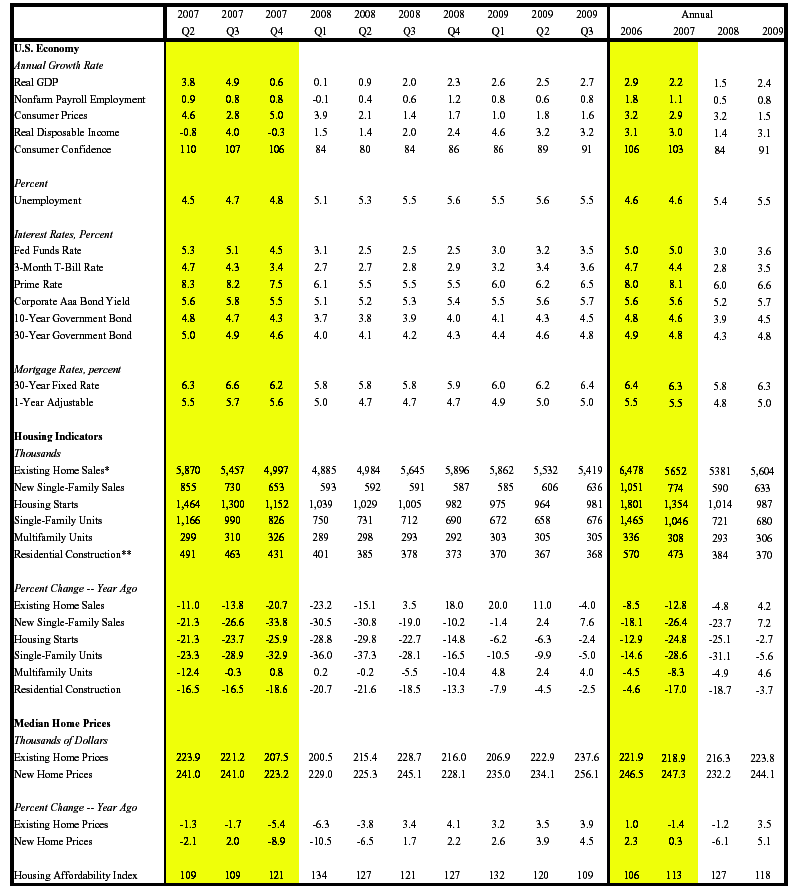
As seen in the above table, the GDP is seen to continuously be continuously low through the quarters of 2008 and would be expected to breach the 2.0 figures late in Quarter 4 of 2008. The figures for unemployment are expected to show a small rise and would hover in the 5 to 5.5 range till quarter 4 of 2009. Consumer confidence index which as at a level of 110 in Quarter 1 of 2007 would continue to slide and reach low levels of 84 in quarter 2 of 2008 and then make small gains to around 91 till quarter 4 end of 2009.
Bergsten (May 2007) has raised some worrying issues related to the current account deficit. According to the author, the global current account deficit of the US is now almost $800 billion. This figure is almost 7 percent of US GDP. To finance both the current account deficit and its own sizable foreign investments, the United States must import about $1 trillion of foreign capital every year or more than $4 billion every working day. The situation is unsustainable in both international financial and domestic political and trade policy terms. These global imbalances are unsustainable for both international financial and US domestic political reasons. On the international side, the United States must now attract about $8 billion of capital from the rest of the world every working day to finance the US current account deficit and foreign investment outflows. Even a modest reduction of this inflow, let alone its cessation or a sell-off from the $14 trillion of dollar claims on the United States now held around the world, could initiate a precipitous decline in the dollar. Especially under the present circumstances of nearly full employment and full capacity utilization in the United States, this could, in turn, sharply increase US inflation and interest rates, severely affecting the equity and housing markets and potentially triggering a recession. The global imbalances probably represent the single largest current threat to the continued growth and stability of the US and world economies.
According to a report by Reuters (March 26, 2008), economies and countries across the world would face problems when the US goes into recession. Countries such as China and Japan look to US markets are the key drivers for the economy and any fall in the exports, fall in demand would have a quick effect on the economies of these nations. Japan is the world’s second-largest surplus country, with a current account imbalance of $167 billion in 2006, and a holder of foreign exchange reserves. Japan must play an important role in the correction of the global imbalances. The Yen was artificially devalued and stood at 120:1 to the dollar. However, since the past month, the Yen is becoming stronger and has reached a value of less than 100:1 to the dollar. Such steep drops have a telling effect on the interest rates and profits as manufacturers find it difficult to recoup their losses.
Recommendations to FED to improve the US Economy
The following recommendations are suggested to help improve the US Economy:
Reduce the US external deficit and the counterpart surpluses, especially in China and Japan, by substantial amounts in as orderly a manner as possible. The goal of US adjustment should be to cut the US global current account deficit to 3–3.5 percent of GDP, about half its present level, at which point the ratio of US foreign debt to GDP would eventually stabilize and should be sustainable. China’s goal, already accepted in principle by its political leadership but without much policy follow-up, should be to totally eliminate its global current account surplus and stop the build-up of foreign exchange reserves. Japan should pare its surplus to perhaps 1 percent of its GDP (Bergsten, May 2007).
FED should notify the Chinese that, if China fails to make a significant “down payment” appreciation of at least 10 percent prior to the release of the US Treasury’s next semi-annual report, it would be labeled a “manipulator.” This action would trigger an explicit US negotiation with China on the currency issue (Bergsten, May 2007).
Adjustment of the US currency should not be allowed to help other countries. It should be best left to the market forces for adjustment of the exchange rates. Any motion on the part of the US to halt its slide against the Yen, Euro, or Rupee should be forbidden as such a move will create an artificial prop for the currency, cause a large-scale downturn of foreign economies and bring the world into a global recession.
Technology innovations in power and energy should be implemented so that the dependence on crude oil that has seen the rise of more than 104 USD per barrel is stopped. OPEC and other countries should be shown that such as huge rise in the crude rate does not help anyone as inflation will devalue any notional increases in revenue.
Conclusion
The paper has examined the state of the US economy for 2007 to 2008 and the study reveals that there is a slide in the US GDP, a fall in exports, a fall in consumer demand, and an increase in the unemployment figures. Certain recommendations have been made to help FED to reduce the ill effects of the downturn and gradually bring the economy back on its track.
References
Amadeo Kimberly. 2008. US Economy: Regional Banks Will Pump Another $100 Billion into Mortgages. Web.
BBC. 2008. US economy at a glance. Web.
BEA, 2008. GDP for Fourth Quarter 2007: Bureau of Economic Analysis. Web.
Bergsten Fred. 2007. US Current Account Deficit: Currency Misalignments and the US Economy. Web.
Bush George. February 2008. Economic Report of the President: White House. Superintendent of Documents, U.S. Government Printing Office, Washington USA. ISBN 978-0-16-079822-1.
Scherer Ron. 2007. U.S. economic forecast for 2008 Bleak. Web.
Molony Walt. 2008. Existing Home sales rise in February. Web.
Reuters. 2008. Japan’s February exports rise despite U.S. slowdown: International Herald Tribune. Web.
